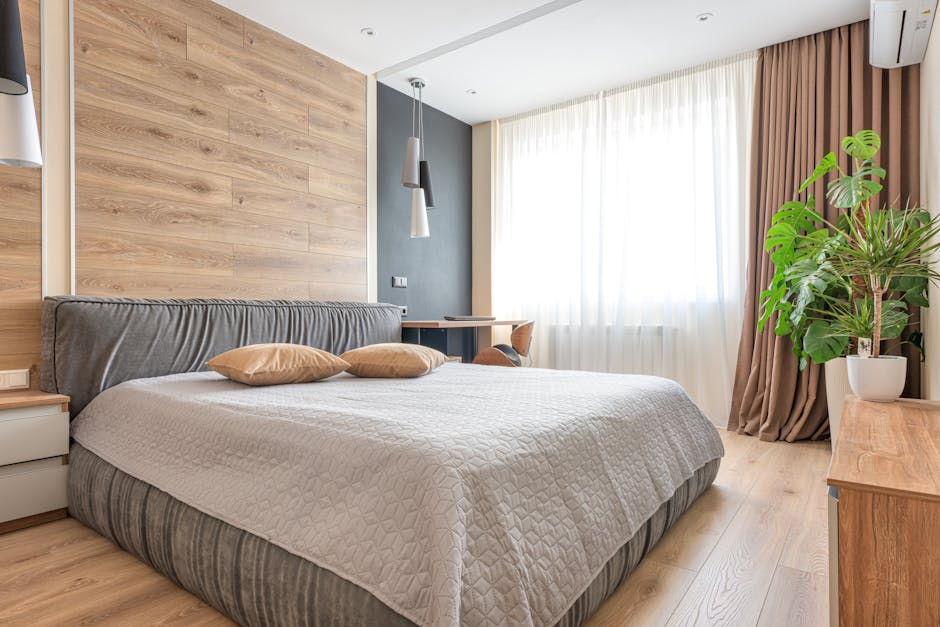Include a TLDR section at the beginning.
Include an FAQ section at the end.
Here's the article:
So, you’ve got a living room that’s pulling double duty as your bedroom? No sweat! Loads of people are in the same boat. We’re here to help you make this space both functional and stylish, so you don’t feel like you’re living in some kind of storage unit. Let’s get into the details, from choosing the right sofa bed to incorporating clever storage solutions and creating a relaxing atmosphere, you’ll find some killer tips here.
TLDR; Turning your living room into a comfy bedroom is totally doable. Focus on multifunctional furniture, smart storage, creating distinct zones, and adding personal touches to make it feel like home. Also, don't forget about room darkening curtains to get solid sleep!
Multifunctional Furniture: The Key to a Dual-Purpose Space
The furniture you select are gonna be your friends, your partners. A proper living/bedroom setup depends on them. Forget bulky, single-use items. We need things that can do more than one thing.
-
Sofa Beds: Obvious, right? But not all sofa beds are created equal. Look for ones with good reviews, especially focusing on comfort. Nobody wants to sleep on bars and springs all night. Consider a sectional sofa bed for extra seating and sleeping space. Pull-out models, futons, and click-clack designs exist, but remember that their mechanisms may be less durable.
-
Coffee Tables with Storage: Hidden storage beneath a coffee table? Genius. Stow away blankets, pillows, books, remote controls. And also, get this, some come with lift-top features which lets you use it as a desk.
-
Ottomans with Storage: These are like small chests disguised as footrests. Perfect for storing spare linens, shoes, or anything else you want out of sight.
-
Wall Mounted Folding Desk: When you need to work, fold it out. When you’re done, fold it back. Boom, extra space.
-
Murphy Beds: It costs more but if you have it in the budget, then this is the real deal. A bed that folds into the wall? That sounds like a proper trick out of some magic show.
Room Dividers: Creating Distinct Zones
Separating the "living" space from the "sleeping" space is crucial for mental wellbeing. No one want to feel like they live in the office. Room dividers can help achieve this, and they don't have to be boring.
- Bookshelves: A classic for a reason. Not only provide storage, but create a visual barrier.
- Curtains: Easy to install and can be adjusted as needed. Plus, they add a soft, cozy feel.
- Screens: Decorative and portable. They come in various styles, from traditional to modern.
Storage Solutions: Keeping Clutter at Bay
Clutter = stress. And nobody wants to stress in their living/bedroom. Implement these storage ideas.
- Under-Bed Storage: If you don't have a sofa bed or Murphy bed, utilize space under your regular bed frame. Storage containers or drawers will keep items organized and out of sight.
- Wall Shelves: Make use of vertical space. Shelves can hold books, plants, decorations, and even clothes if you're really tight on space.
- Storage Baskets: Place them strategically around the room to collect smaller items like magazines, toys, or extra cushions.
Lighting: Setting the Mood
Lighting is your secret weapon to transform any room from bright & functional to calm & inviting.
- Dimmable Lights: Install dimmers on your main lights so you can adjust the brightness depending on the time of day and your activity.
- Lamps: Table lamps, floor lamps, and bedside lamps can create a softer, more relaxed atmosphere than overhead lights.
- String Lights: Add a touch of whimsy and warmth with string lights. They're perfect for creating a cozy vibe.
Color Palette & Decor: Creating a Harmonious Space
The colors you choose can influence your mood, so select a color scheme that promotes relaxation and tranquility.
- Neutral Colors: These are your foundation. Soft grays, beiges, and whites create a calming backdrop.
- Accent Colors: Add pops of color with throw pillows, blankets, artwork, and accessories. But don't overdo it. A few well-chosen accent pieces can make a big difference.
- Personal Touches: Decorate with items that bring you joy – photos, souvenirs, artwork. These personal touches will make your space feel more like home.
Textiles: Adding Comfort and Texture
Soft textiles are essential for creating a cozy and inviting space.
- Rugs: A large area rug can anchor the room and define the different zones.
- Throw Pillows: These are an easy way to add color, texture, and comfort to your sofa or bed.
- Blankets: Keep a throw blanket handy for snuggling up on the couch or adding an extra layer of warmth to your bed.
- High Thread Count Sheets: Invest in good quality bedding. It can really make a difference in your sleep quality.
Soundproofing: Minimizing Noise Disturbance
If you live in a noisy area, consider soundproofing measures to improve your sleep quality.
- Thick Curtains: Heavy curtains not only block out light but also absorb sound.
- Rugs and Carpets: Soft surfaces can help absorb sound and reduce echoes.
- Acoustic Panels: These can be installed on walls to reduce noise levels.
Maintaining the Space: Keeping it Functional and Tidy
Regular maintenance is key to keeping your living/bedroom functional and enjoyable.
- Make Your Bed Every Day: A made bed instantly makes the room look tidier.
- Declutter Regularly: Get rid of items you no longer need or use.
- Clean Regularly: Dust, vacuum, and wipe down surfaces to keep the space clean and healthy.
Specific Furniture & Style Ideas
Consider the following specific furniture and design ideas, bearing in mind that individual choices are going to be somewhat subjective.
- Minimalist Design: Less is more. Opt for simple, clean lines and a muted color palette.
- Bohemian Style: Layer textures, patterns, and colors to create a relaxed and eclectic vibe.
- Scandinavian Design: Focus on functionality, simplicity, and natural materials.
- Industrial Style: Incorporate raw materials like metal, wood, and concrete for an urban aesthetic.
The Science Behind Sleep and Design
Did you know that the color of your walls can affect your sleep? Studies have shown that blue and green are calming colors that promote relaxation, while red and yellow can be stimulating. And light is super important to our sleep rhythms. Make sure that you have blackout curtains or blinds to block out light, especially if you live in an urban area. If you want to, you can get yourself an eye mask.
Also, the temperature of your room can affect your sleep. Experts recommend keeping your bedroom between 60 and 67 degrees Fahrenheit for optimal sleep. That may seem a bit chilly but don't worry, just add a soft blanket.
Budget-Friendly Tips and Tricks
Decorating a living/bedroom doesn't have to break the bank. Here are some budget-friendly tips and tricks:
- Shop Secondhand: Check out thrift stores, flea markets, and online marketplaces for affordable furniture and decor.
- DIY Projects: Get creative and make your own decor items. There are tons of DIY tutorials online.
- Repurpose Items: Give old items new life. Turn a ladder into a bookshelf or a pallet into a coffee table.
- Focus on Essentials: Prioritize essential items like a comfortable sofa bed and storage solutions, and then add decorative touches as your budget allows.
Additional Considerations: Pet Owners and Allergies
If you have pets, be sure to choose furniture and materials that are durable and easy to clean. Leather or microfiber are good options for sofas, and washable rugs are a must. Also, consider investing in an air purifier to reduce allergens and pet dander.
For those with allergies, choose hypoallergenic bedding and materials. Avoid heavily scented candles and air fresheners, and clean regularly to minimize dust and allergens.
The Future of Multifunctional Spaces
As living spaces become smaller and more expensive, the need for multifunctional rooms will only increase. Expect to see more innovative furniture designs and space-saving solutions in the future. Technology will also play a role, with smart home devices and automated systems making it easier to manage and control your living/bedroom.
In the years to come, we'll likely see an increase in modular furniture that can be easily reconfigured to suit different needs. This will allow you to quickly transform your living/bedroom from a workspace to a relaxation zone with minimal effort. Imagine a sofa that can be transformed into a desk or a bed with the touch of a button.
Conclusion
Creating a living room that doubles as a bedroom requires careful planning and thoughtful design. By focusing on multifunctional furniture, smart storage solutions, and creating distinct zones, you can create a space that is both functional and stylish. Remember to personalize your space with items that bring you joy and make you feel comfortable. With a little effort, you can transform your living room into a cozy and inviting haven that you'll love spending time in. Make sure to consider the science that dictates a good night sleep. With the right setup, you'll be dreaming away.
FAQ: Making Your Living Room a Bedroom
-
How do I make my sofa bed more comfortable?
Add a mattress topper, use high-quality sheets, and invest in comfortable pillows. This makes a world of difference to the sleep you'll get.
-
How can I block out light in my living room?
Use blackout curtains or blinds. Also, consider adding an eye mask for extra darkness.
-
What are some good storage solutions for small spaces?
Utilize vertical space with shelves, use under-bed storage, and invest in furniture with built-in storage.
-
How can I create a distinct sleeping zone in my living room?
Use room dividers, curtains, or bookshelves to separate the sleeping area from the living area.
-
What colors are best for creating a relaxing atmosphere?
Soft grays, beiges, and blues are great choices.
-
How often should I clean my living/bedroom?
Aim to clean it at least once a week to keep it tidy and healthy.
-
What are the best types of sofa beds for everyday use?
Pull-out sofa beds with a high-quality mattress are generally the most comfortable for everyday use.
-
How can I minimize noise disturbance in my living/bedroom?
Use thick curtains, rugs, and acoustic panels to absorb sound.
Last modified: June 14, 2025



